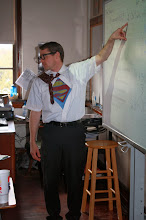Virtual field trips are an excellent way to help students learn information and ready their minds to learn additional information in the future. A virtual field trip gives students a strong episodic memory that is easy for them to recall later. This episodic memory can be linked to all of the important information covered over the course of a topic. For example, if you were studying the economics of supply and demand you could take students on a virtual field trip of a candy making factory or some other entertaining factory. Students would have a fun experience learning about how candy is made and you could tie in the ideas of supply and demand as you are leading the class through the virtual field trip.
Virtual field trips can also be used as a catalyst to get students to retain information for much broader topics. A virtual tour of Boston of 1775 or of Washington’s plantation could be used as a catalyst for a Revolutionary War topic. Long term memory is stored in networks of information and students could use the virtual field trip to tie together a network of Revolutionary War information in their long term memories. Virtual field trips also give students a visual to tie to the information they are learning. According to Paivio’s duel coding hypothesis information is stored as both images and text so having visuals becomes important of the storing of information into memory.
I wanted to finish this post with a quick discussion about a few other cognitive technology tools that can help students process and retain information.
Using video clips is a great way to connect learning to something visual. Videos can also create an episodic memory for students if they enjoy the video. Math and science classes could easily go a step further and have the students create videos that show a mathematical or scientific concept in action. Students can then apply their math knowledge to the video they created.
Graphic organizers help students create network connections between different parts of the same topic. Using graphic organizers is an excellent way to show students how different ideas are connected together. Inspiration software is a good graphic organizer building software and FreeMind is a free graphic organizer building software that can be found at http://freemind.sourceforge.net/wiki/index.php/Main_Page.
Class made wikis are another tool that can create connections between topics in a unit and give students an episodic memory. There are several ways to create a wiki as a class. One method would be to assign different topics to groups, pairs, or individuals and have them research and create a wiki page for that topic. Once all of the pages are created the class can view each page and make a concept map that connects all of the topics. Once the concept map is agreed upon the pages of the wiki can be linked together to match the concept map.
Wednesday, May 19, 2010
Subscribe to:
Post Comments (Atom)


Ryan,
ReplyDeleteAs a third grade teacher in Georgia, we cover supply and demand in our curriculum. I wish this would have been posted a few months ago so that I could have used your suggestion! I think that a virtal field trip to somewhere such as a candy shop would definetly create episodic memories for my third graders. That is a hard concept for them to grasp, but your idea will be beneficial next year! As you refered to Paivio’s duel coding hypothesis, the virtual field trip would help the students visually. A concept map would also be a great cognitive tool to reach the students through text. Thank you for your suggestions on many different types of cognitive tools!
Ryan,
ReplyDeleteWhat fun activities for your classes, and the knowledge they will gain from these lessons! Have you ever had your students make a commercial video taping, with a math concepts. Students love this!
I really like the idea of the class making a concept map using wiki. Using that same idea you have you could use it to make a virtual field trip.
ReplyDelete